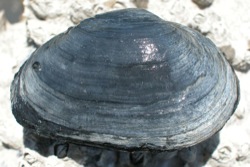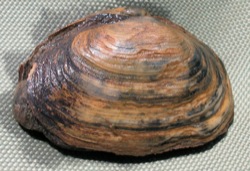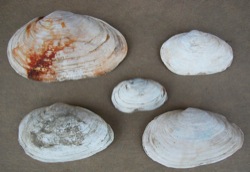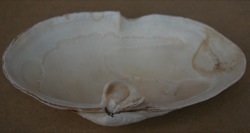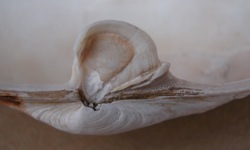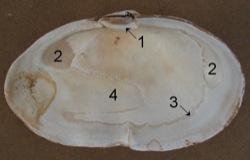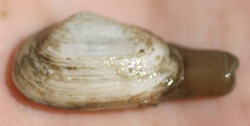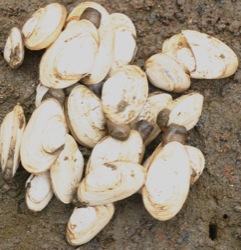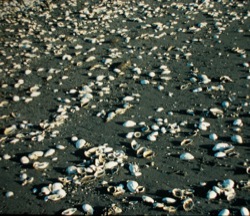Mya arenaria Image 4-five left valves
Left valves of
Mya arenaria shells collected from San Francisco Bay shores. The head ends of the shells are to the left. The largest is about 10 cm long.
Return to Top
Mya arenaria Image 3-stained shell
Mya arenaria from San Francisco Bay, with its shell stained rusty from the mud. The head end is to the left, and the siphons protrude slightly at the right.
Return to Top
Mya arenaria Image 2-dark shell
Mya arenaria from San Francisco Bay, with its shell stained dark from the anoxic mud it was living in. The head end is to the right.
Return to Top
Mya arenaria Image 1 & Key
Mya arenaria from San Francisco Bay. The head end is to the right, with the dark siphons protruding slightly from the hind end of the shell at the left.
Return to Top
Mya arenaria Linnaeus, 1758
SOFT-SHELL CLAM, EASTERN SOFT-SHELL CLAM, LONG-NECKED CLAM, STEAMER CLAM, SAND GAPER
Mya arenaria has a chalky white, oval shell which is rounded
at the head end and slightly pointed at the hind end. It can reach up to
15 cm in length. Young clams have a thin gray, yellow or brown tissue covering
the shell, which is worn away in older clams except around the shell margins.
In some areas the shells are reported to be blue-white or brownish-white
rather than chalky white, and the mud the clam lives in can stain the shell
rusty or black.
Return to Top
Musculista senhousia Image 5
Closeup of the
Musculista senhousia mat. A few anemones (
Diadumene lineata) attached to the mussels are visible at the left and lower right.
Return to Top
Musculista senhousia Image 4
A mat of
Musculista senhousia, within a bed of the larger bay mussel (
Mytilus trossulus-galloprovincialis complex) on the east shore of San Francisco Bay.
Return to Top
Musculista senhousia Image 3
Musculista senhousia from San Francisco Bay, with its siphons extended upward from the hind end of shell, and its long foot extended to the lower left corner of the image.
Return to Top
Musculista senhousia Key Image
Another specimen from San Francisco Bay. This one lacks the dark, wavy, concentric lines, and the radiating lines are pale purple against a greenish-yellow and brown background. Note the very slightly concave lower edge of the shell, at left.
Return to Top
Musculista senhousia Image 1
Musculista senhousia from San Francisco Bay. Note the shell’s green tint, faint purple radiating lines, and dark purple-brown, wavy, concentric lines.
Return to Top

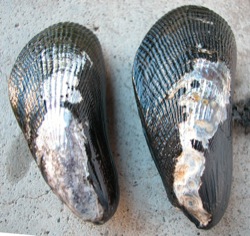 Geukensia demissa
Geukensia demissa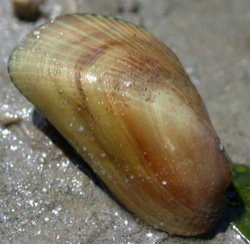 Musculista senhousia
Musculista senhousia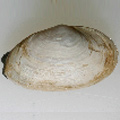 Mya arenaria
Mya arenaria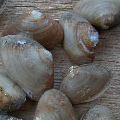 Corbula amurensis
Corbula amurensis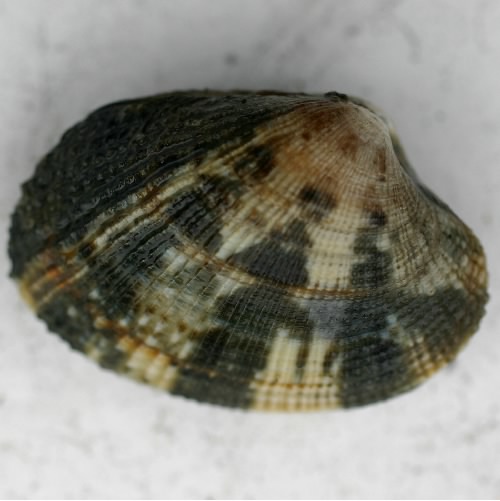 Venerupis philippinarum
Venerupis philippinarum
